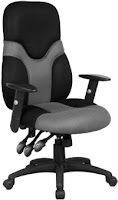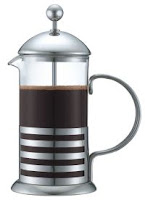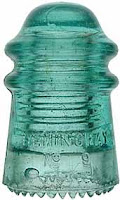As a grad student or new professor, you'll likely be spending hours (and hours, and hours) sitting in your office doing supposedly scholar-like things. Here are some things I've found extremely useful for writing and conducting research while sitting in my office. Maybe they'll be useful in thinking about what you'd like in your office to help make you more productive, happy, or both:

 |
| Perfect for slouching! |
1. A High-Back, Comfortable Rolling Chair with Arms. I prefer a rolling/swiveling chair with 'arms' that can fit right up to my desk and that also allows me to 'slouch' in it while writing (my preferred writing position, bad back be damned!). My current chair also has the ability to lean back pretty far without tipping over (don't ask how I know the limit of this), which allows me to put my feet up on my desk when I'm reading a physical book or paper. One of the most important things, for me, is that it is a 'high back' chair that I can actually lean back in, if I so choose,
without the top of the seatback breaking my spine in two like a sweet
Moral Kombat finishing move. I've tried the smaller 'secretary' chairs before, and they always end up hurting my back after a week or so. Part of that could be that, in the words of a friend, I'm "big as sh*t!", but I like to think that it's instead because I'm now a professor, not a secretary, and so my body desires the finer professorial things in life.
(But seriously, it's probably because I'm big as sh*t and should lose some weight.)
2. Dual Monitors. The jump in productivity this option gives you is simply amazing. I have a 17" laptop that's essentially a desktop replacement, and use an external monitor attached to it that lets me use dual-screens. I can be writing in a manuscript on one, and have Stata, EndNote, Google Chrome, PDF files, etc. open on the other without having to swap back and forth. It's also nice when I'm using the Stata program for something, and can have the syntax file open for editing at the same time. Most laptops will automatically be able to support dual monitors (that is, the laptop screen and 1 external monitor), but small laptops and netbooks may not, so keep this in mind when selecting a laptop. Also, dual monitors on a desktop may require a special video card (or multiple video cards), that may not come standard on an off-the-shelf desktop.
 |
| Screenshot of Endnote |
3. Citation Tracking Software. I use EndNote, though I know others who think it has a massive learning curve to get to work right (and even then, it's prone to bugs and crashes). Using any kind of citation software that links in with your writing software (I use MS Word) will save you countless hours of formatting citations, cross-checking things, and making the bibliography at the end. Also, with the right software, you can also keep track of your notes and have PDFs of the actual articles linked to each citation entry. If you don't have a citation manager, start NOW, and throw everything you get your hands on into it. The time you take setting up the entries initially will pay dividends for years to come.
 |
Like a filing cabinet,
but actually useful! |
4. Dropbox Software. Dropbox is software that lets you store files in your online 'Dropbox', but it acts as if it's a simple folder on your computer that you can drag and drop files into, rename things in, etc. The best part, aside from the automatic backups stored offsite (and the backup history option, which has saved my ass in the past), is that you can link multiple computers to a single Dropbox account and thereby 'sync' all of your important folders and files between these computers. I have my EndNote file/folders in my Dropbox, and this lets me get to my citations from wherever I am, assuming I have EndNote installed on that computer. I also installed Stata into a folder within my Dropbox folder, allowing me to use it from any of my three linked computers. You can get your free 2GB dropbox account here:
http://db.tt/QLD94wc. They also have paid accounts with much more space.
5. Noise Canceling Headphones. When doing work that doesn't require a lot of 'quiet time' concentration (like data cleaning), I like to listen to music through a pair of Phillips noise cancelling headphones. They run on a single AAA battery, and you can definitely hear a difference when the noise cancellation is turned on (background noise is more 'hushed'). They still work great as regular headphones when turned off, and they're the type that cover the entire ear. If you're looking to buy a pair of these, make sure you get the
active noise canceling kind, and not the
passive noise isolating kind. The difference is that the active noise cancelling ones electronically damper external noises, while noise isolating are ones that just try and physically block out the sound waves. The only trick is to these headphones is that you need to remember to turn
off the headphones when you're done, otherwise they can double as a AAA-battery-quickly-drainer (with all due respect to
Mitch Hedberg, R.I.P.).
 |
| Yep, that's about right |
6. A Red Pen. While most of my writing is done electronically, when I'm proofing or otherwise reviewing something, I like to actually print it out on paper and go through it page by page, marking errors as I find them and making notes in the margins. For that, I can use red ink to make any changes, and it's easy to spot them later when I go through and fix the electronic document. I also learned at one of my previous jobs that by putting a small checkmark in the right margin whenever you make a change on the paper, it's easier to find all of your changes later on no matter how minute they might be. As I transfer these changes to the electronic document, I circle the checkmark in the margin to show that the change has been made. Red pens are also great for grading papers, as there's nothing that says 'Wow, this is totally wrong' to undergrads as a graded paper that's filled with red ink.
 |
They come pre-sticky.
Try not to think about how they do that. |
7. Sticky Notes and a Large Writing Pad. When I'm reading articles (typically online as electronic PDFs), as things pop into my mind I jot them down on a pad of paper under a heading that relates to what I'm doing (e.g., "Media examples to use in paper"). When I have something that I want to remember later and it's REALLY IMPORTANT, I'll put it on a sticky note and place the note on the wall next to my desk. These notes might be something like an important phone number, a formula I'm going to need to refer to over and over again over the next few weeks, or snippets of data that I'll need to reference in my methods section (like how many cases were excluded from a sample and for what reasons).
 |
Meet Bunga Bunga.
Yes, he's holding a
severed head. |
8. Interesting Things to Look At. So I typically stare at a computer screen for hours and hours on any given day. That's a horrible thing for both my eyes and my sanity. When I need a break, it's nice to just push back from the computer and looks elsewhere. Whether that's staring out the window, or at the pictures/things around my desk, I need something to keep my mind distracted from the computer screen. So rather than staring at a blank wall, I've got a couple of weird statutes (see image on the left for an example), paper weights, pictures of my family, and other interesting posters that I like looking at. I like to think they keep me sane, but even if they don't, they at least make for interesting conversation pieces when someone stops by my office.
 |
Surrenders faster than
a regular coffee press |
 9. French-Press and Coffee/Accessories.
9. French-Press and Coffee/Accessories. So I admit, I'm not coffee's biggest fan. When served black with nothing in it, it tastes absolutely horrible. To me, coffee is mostly used as a medium to provide my mouth with copious amounts of sweetener (Splenda) and sugar-free hazelnut or french vanilla creamer. However, a cup or two in the morning does help me focus on working on my research, so I figured if I'm going to drink coffee, it'd better be damned good coffee. I also don't want to drop $2-4 per cup at Starbucks. Therefore, I bought myself a little french press ($10) that's good for a couple of cups of coffee at a time. I buy a couple of pounds of good coffee (1# decaf, 1#...umm... caf? recaf? whatever.) at a time (use the 'french press' crush setting!), store it in a couple of airtight containers ($5 each), supply the Splenda and (powdered) creamer I previously mentioned, and have a nice big coffee mug and associated coaster. Since I have access to an office water-cooler that provides (almost) boiling hot water, I can make my own french-pressed coffee whenever I want, with very little effort and expense. The only pain to this method is having to clean the grounds out of the press every day, but that only takes a minute or two in the restroom sink, and if I'm saving a few bucks per cup, I can't really complain all that much.
 |
Science and History
combined! Muahaha! |
10. A/C, a Small Fan (and Associated Paperweights). I'm the type of guy who likes cool weather, preferably 65 degrees with a breeze. My office has self-controlled A/C, and on my desk, I've got a small fan and a few paperweights placed strategically on important piles of paper that I don't want to blow away (I obviously don't care if the unimportant papers blow away). The paperweights also offer an opportunity to provide something interesting to look at (see #8). One interesting type of paperweight I'm currently fascinated with are old glass power-line insulators. You can find them cheap at flea markets and antique stores (~$5/each), and every one is a unique piece of history. They're about 3-4" in height, and maybe 2.5" in diameter. Other ideas for paperweights could be small statues, office suppliers (tape dispenser?), those large blocks of sticky notes (see #7), or deactivated metal grenades (yes, I've thought about this, and will be checking with my department head soon...).
I'll add more things as I think of them, and if you have any recommendations, let me know!
---------------------------------------------
Picture Credits:
Headphones Sticky_Note Glass_Insulator Red_Pen Dual_Monitors Others: Amazon.com












No comments:
Post a Comment